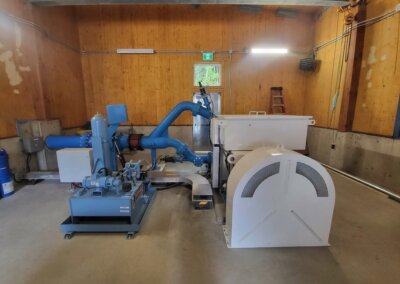About the Project
The project is a run-of-river hydropower facility on Ahtaapq Creek, 2 km north of the Refuse Cove village on Vancouver Island. The project is owned by the Hesquiaht First Nation (HFN), in an area of overlapping interests of both the Hesquiaht and Ahousaht First Nations.
The community at Refuge Cove is not connected to the provincial power grid and has relied on diesel generation for its electricity. This project aims to displace most of the diesel generated power with clean, renewable hydroelectric energy. The facility, with a power flow of 0.19 m3/s, generates up to 350 kW of renewable energy. Power from the hydro facility has the potential to displace over 90% of the diesel consumption in the winter months and over 70% annually.
HFN members played critical roles during site investigation and project design. They supported and accompanied all fieldwork activities and provided valuable logistical and historical knowledge of the area. The HFN were at the table for all critical decisions during the project’s evolution, leading the project with perspective and clarity based on their values.
The key project components are:
- An intake to divert power flows into the penstock, comprising a rockfill dam and polyethylene membrane liner to create a headpond, an inlet structure and stilling well.
- A tributary intake system that collects water from seven downstream tributaries and feeds it to the headpond.
- A conveyance penstock with a total length of 2325 m, most of which is buried Ø400 mm polyethylene pipe, and the remainder is Ø400 mm steel pipe supported on steel bents.
- A Ø1050 mm branch pipe that tees off the penstock providing surge attenuation.
- A sustainable mass-timber powerhouse with an 80 m2 plan footprint, housing a twin-jet 350 kW Pelton turbine, generator, and supporting equipment supplied by Dependable Turbines.
- The project reactivated approximately 2200 m of abandoned forest road and constructed roughly 375 m of new access road.
Approach
The design team took a collaborative approach and the civil, geotechnical and hydrotechnical team worked closely with the project managers and Hesquiaht First Nation to develop solutions that met the Nation’s values and the project budget.
Our team developed innovative designs for key project components, allowing for the implementation of cost-effective and efficient solutions.
Traditional rockfill dams use low-permeability clay or impermeable wall type cores. No obvious source for clay material was identified at the site. Wall cores are erected full height, limiting access, and the flashy catchment increases the risk flooding could destroy work in progress. The solution selected involved the erection of a lock block wall supporting an LLDPE membrane core on the upstream face. As rows of blocks were erected, the membrane was unrolled, and the rock fill placed on either side. This sequence created an impermeable barrier while providing a stable intermediate state with a lower risk of damage overtopping due to flood.
The tributary intake system required a low-cost and low-maintenance solution; Coanda or Tyrolean intakes were cost-prohibitive. The tributary system used modified overdrain crossings with lock blocks, and cement treated fill diversion structures to send water to a modified roadside ditch and direct it to the headpond.
The powerhouse is built from mass timber, allowing for accelerated erection, and creating a green sustainable BC sourced timber building.
Results
The project is currently generating clean renewable hydroelectric energy for the Hesquiaht First Nation community at Refuge Cove. The addition of the hydroelectric facility is significantly reducing the community reliance on diesel generated power. In the first winter and spring of operation, the facility delivered on average, over 70% of the community demand and over 90% in the high rainfall months minimizing the associated risks inherent with the delivery, storage and burning of diesel fuel.
Service(s) Provided
Project Technical Design Coordination
Civil Engineering
Structural Engineering
Hydrotechnical Engineering
Construction Phase Engineering
Project Team (Consultants)
Barkley Project Group
New Energy Design
Allegro One Consulting
Hakai Energy Solutions
Central West Coast Forestry Society
Project Team (Contractors)
Speers Construction
VVI Construction
Dependable Turbines
Go back to projects in
View other projects from
Stay in touch with us
Subscribe to our mailing list!
Organization
Connect





